Do you have a question about the Eaton FD120 and is the answer not in the manual?
Details the capabilities and components of the DIESEL Plus controller.
Covers power supply requirements, voltage options, and protection features.
Describes how the controller indicates alarms and system status.
Details the 4-line, 40-character backlit LCD display capabilities.
Explains the function of green status and red alarm LEDs.
Covers statistics, diagnostics, and message history storage.
Lists configurable options like languages, timers, and inputs/outputs.
Describes enclosure types (NEMA) and ratings.
Lists supply voltage, frequency, temperature, and certifications.
Details the dual 10 Amp battery chargers and their functions.
Details input and output terminals on the engine board.
Provides wire size recommendations for terminals and distances.
Details cable sizes for LMR Plus controller connections.
Specifies wire sizes for DIESEL Plus controller terminals.
Lists available language settings for the controller.
Lists various optional features and configurations available for the controller.
Lists standards and approvals the controller meets.
Describes internal component mounting, wiring, and battery chargers.
Details pressure sensing and the types of output relays provided.
Covers enclosure types and programmable microprocessor parameters.
Details the LCD screen and status/alarm LEDs on the operator panel.
Explains capabilities like USB, Ethernet, RS485 ports, and embedded web page.
Covers specific operational aspects like Fail-to-Start alarms and timers.
Details low suction shutdown functionality and LED testing.
Outlines the organization of the controller's programming menu.
Explains how to configure custom inputs, outputs, and LEDs.
Describes the seven different displays available on the LCD.
Explains the meaning and behavior of all status and alarm LEDs.
Details the operations of the control panel pushbuttons.
Covers general safety, precautions, and warnings for installation and operation.
Introduces the DIESEL Plus Controller as a multi-function microprocessor unit.
Details controller mounting requirements and pressure sensor connections.
Provides guidelines for making electrical connections, including conduit and wiring standards.
Introduces the controller hardware and its components.
Explains the operation and features of the three-step battery chargers.
Describes the accessibility and functions of the front operator panel.
Covers AC input fuse protection, charger setup, and forced charging.
Lists technical specifications for the battery chargers.
Details the functions of the front operator panel, including alerts and manual start.
Explains the function of all LEDs and control pushbuttons on the panel.
Describes access to the display board and the function of the Power I/O Board.
Details the Engine Board and external pushbuttons like stop.
Explains the function of the stop pushbutton.
Covers manual and automatic start sequences and program descriptions.
Details the available control inputs and their descriptions.
Explains Run Period Timer, Sequential Start Timer, and various alarms.
Details output relay functions and specific engine alarm conditions.
Covers the basics of controller programming and menu navigation.
Explains the functionality and programming of RPT and SST.
Details the states and operations of various control inputs.
Describes alarms for DC power loss, speed switch, starter coils, and power failures.
Explains the functions of engine run, future relays, and common alarm relays.
Details specific engine alarms like Overspeed, Fail To Start, and High Temperature.
Details configuration for pressure sensor, start/stop points, and alarms.
Covers programming for RPT, Weekly Test Timer, AC Power Failure, and SST.
Explains configuration for custom inputs/outputs, lights, and main menu password.
Details Auto Shutdown, Proof Pressure Switch, Low Suction, Pressure Deviation, and Hourly Recording.
Explains settings for RPT, Weekly Test, AC Power Failure, and Sequential Start Timers.
Describes how to program custom inputs, outputs, and lights.
Details input labels, common alarm linking, relay/light linking, latching, state, and timer settings.
Explains output relay settings like latching, fail-safe, and timer functions.
Details how to program custom LED indicators.
Describes remaining output relay functions and custom light programming.
Explains how the controller records and displays history, diagnostics, and statistics.
Focuses on viewing and saving system history messages.
Details how to view and save controller diagnostic information.
Explains USB port usage for data download, upload, and firmware updates.
Covers the optional embedded webpage and other communication protocols.
Describes optional serial port connectivity for communication and printing.
Outlines the process for creating and formatting custom message files for the controller.
Provides a numbered list of specific alarm events used for custom messages.
Explains the use of common alarms as triggers for custom messages.
Illustrates the main menu hierarchy and navigation paths.
Details the menu tree for changing date and time settings.
Shows menu flow for configuring pressure sensor and start/stop points.
Illustrates menu paths for pressure alarms, auto shutdown, and low suction settings.
Details menu navigation for Run Period Timer and RPT Start Mode.
Shows menu paths for Weekly Test Timer, AC Failure Alarm, and Start Timers.
Illustrates the navigation for configuring custom inputs.
Shows the menu structure for configuring custom outputs.
Details the navigation for programming custom lights.
Covers selecting input type, setting labels, and audible alarms.
Details linking inputs to relays/lights, latching, and input state configuration.
Shows how to select relays and alarm types for custom outputs.
Details configuration for latched relays, fail-safe, and delay timers.
Details the process for selecting and configuring custom lights.
Illustrates the steps for selecting and setting up a main menu password.
Explains how to load custom messages into the controller.
Details how to select, enable/disable, and view custom messages.
Specifies wire gauge for control wiring and exceptions.
Provides wire gauge and distance guidelines for battery connections.
Lists and describes various alarm messages the controller can generate.
Continues the list and description of alarm and status messages.
Guides the user through performing automatic and manual start tests.
Explains how to perform a manual engine test.
Details how to conduct a weekly exerciser test for the engine.
Details the capabilities and components of the DIESEL Plus controller.
Covers power supply requirements, voltage options, and protection features.
Describes how the controller indicates alarms and system status.
Details the 4-line, 40-character backlit LCD display capabilities.
Explains the function of green status and red alarm LEDs.
Covers statistics, diagnostics, and message history storage.
Lists configurable options like languages, timers, and inputs/outputs.
Describes enclosure types (NEMA) and ratings.
Lists supply voltage, frequency, temperature, and certifications.
Details the dual 10 Amp battery chargers and their functions.
Details input and output terminals on the engine board.
Provides wire size recommendations for terminals and distances.
Details cable sizes for LMR Plus controller connections.
Specifies wire sizes for DIESEL Plus controller terminals.
Lists available language settings for the controller.
Lists various optional features and configurations available for the controller.
Lists standards and approvals the controller meets.
Describes internal component mounting, wiring, and battery chargers.
Details pressure sensing and the types of output relays provided.
Covers enclosure types and programmable microprocessor parameters.
Details the LCD screen and status/alarm LEDs on the operator panel.
Explains capabilities like USB, Ethernet, RS485 ports, and embedded web page.
Covers specific operational aspects like Fail-to-Start alarms and timers.
Details low suction shutdown functionality and LED testing.
Outlines the organization of the controller's programming menu.
Explains how to configure custom inputs, outputs, and LEDs.
Describes the seven different displays available on the LCD.
Explains the meaning and behavior of all status and alarm LEDs.
Details the operations of the control panel pushbuttons.
Covers general safety, precautions, and warnings for installation and operation.
Introduces the DIESEL Plus Controller as a multi-function microprocessor unit.
Details controller mounting requirements and pressure sensor connections.
Provides guidelines for making electrical connections, including conduit and wiring standards.
Introduces the controller hardware and its components.
Explains the operation and features of the three-step battery chargers.
Describes the accessibility and functions of the front operator panel.
Covers AC input fuse protection, charger setup, and forced charging.
Lists technical specifications for the battery chargers.
Details the functions of the front operator panel, including alerts and manual start.
Explains the function of all LEDs and control pushbuttons on the panel.
Describes access to the display board and the function of the Power I/O Board.
Details the Engine Board and external pushbuttons like stop.
Explains the function of the stop pushbutton.
Covers manual and automatic start sequences and program descriptions.
Details the available control inputs and their descriptions.
Explains Run Period Timer, Sequential Start Timer, and various alarms.
Details output relay functions and specific engine alarm conditions.
Covers the basics of controller programming and menu navigation.
Explains the functionality and programming of RPT and SST.
Details the states and operations of various control inputs.
Describes alarms for DC power loss, speed switch, starter coils, and power failures.
Explains the functions of engine run, future relays, and common alarm relays.
Details specific engine alarms like Overspeed, Fail To Start, and High Temperature.
Details configuration for pressure sensor, start/stop points, and alarms.
Covers programming for RPT, Weekly Test Timer, AC Power Failure, and SST.
Explains configuration for custom inputs/outputs, lights, and main menu password.
Details Auto Shutdown, Proof Pressure Switch, Low Suction, Pressure Deviation, and Hourly Recording.
Explains settings for RPT, Weekly Test, AC Power Failure, and Sequential Start Timers.
Describes how to program custom inputs, outputs, and lights.
Details input labels, common alarm linking, relay/light linking, latching, state, and timer settings.
Explains output relay settings like latching, fail-safe, and timer functions.
Details how to program custom LED indicators.
Describes remaining output relay functions and custom light programming.
Explains how the controller records and displays history, diagnostics, and statistics.
Focuses on viewing and saving system history messages.
Details how to view and save controller diagnostic information.
Explains USB port usage for data download, upload, and firmware updates.
Covers the optional embedded webpage and other communication protocols.
Describes optional serial port connectivity for communication and printing.
Outlines the process for creating and formatting custom message files for the controller.
Provides a numbered list of specific alarm events used for custom messages.
Explains the use of common alarms as triggers for custom messages.
Illustrates the main menu hierarchy and navigation paths.
Details the menu tree for changing date and time settings.
Shows menu flow for configuring pressure sensor and start/stop points.
Illustrates menu paths for pressure alarms, auto shutdown, and low suction settings.
Details menu navigation for Run Period Timer and RPT Start Mode.
Shows menu paths for Weekly Test Timer, AC Failure Alarm, and Start Timers.
Illustrates the navigation for configuring custom inputs.
Shows the menu structure for configuring custom outputs.
Details the navigation for programming custom lights.
Covers selecting input type, setting labels, and audible alarms.
Details linking inputs to relays/lights, latching, and input state configuration.
Shows how to select relays and alarm types for custom outputs.
Details configuration for latched relays, fail-safe, and delay timers.
Details the process for selecting and configuring custom lights.
Illustrates the steps for selecting and setting up a main menu password.
Explains how to load custom messages into the controller.
Details how to select, enable/disable, and view custom messages.
Specifies wire gauge for control wiring and exceptions.
Provides wire gauge and distance guidelines for battery connections.
Lists and describes various alarm messages the controller can generate.
Continues the list and description of alarm and status messages.
Guides the user through performing automatic and manual start tests.
Explains how to perform a manual engine test.
Details how to conduct a weekly exerciser test for the engine.
| Brand | Eaton |
|---|---|
| Model | FD120 |
| Category | Controller |
| Language | English |
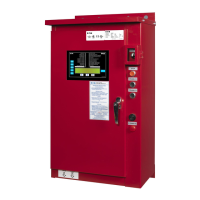
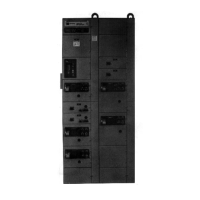
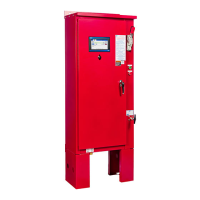


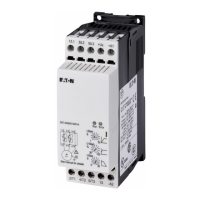
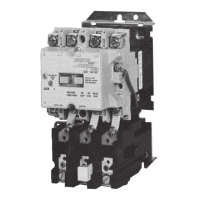

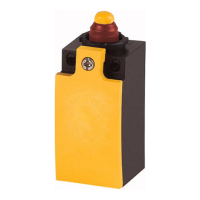
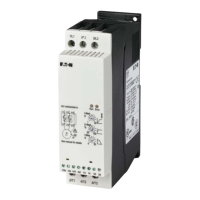
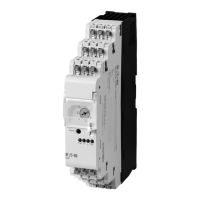
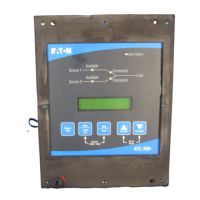
